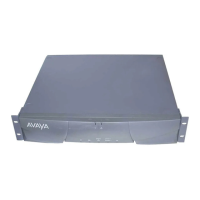Maintenance-Object Repair Procedures
555-233-143
8-1496 Issue 1 May 2002
STRAT-3 (Stratum-3 Clock)
The Digital Synchronization Network Plan (PUB 60110) specifies a hierarchy of
synchronization nodes consisting of Strata 1 to 4, where the public network’s sole
Stratum-1 clock is the most accurate. The Release 5r system supports both
Stratum-3 and -4 operations. See ‘‘Stratum-4 Synchronization’’ on page 8-1511
for details on Stratum-4 operation.
A Stratum-3 clock derives its timing from two DS1 references connected to a
Stratum-3 or better source. The Stratum-3 clock provides a holdover of at least
24 hours should both DS1 references fail. (After 24 hours, the Stratum-3 clock
still provides service but its accuracy may be degraded). The Digital
Synchronization Network Plan (PUB 60110) requires that the Stratum-3 clock
have duplicated components.
The Stratum-3 clock can be configured with only one DS1 input if one of the Clock
Input cards is removed. Also, the Stratum-3 clock can free run (use its internal
clock without using DS1 inputs, if both Clock Input cards are removed).
Only a TN780 Tone-Clock circuit pack recognizes and supports a Stratum-3 clock
and its alarm signals. (The TN780 Tone-Clock circuit pack is also backward-
compatible with a TN768 Tone-Clock circuit pack.) The Stratum-3 clock may be
connected to a non-IPSI EPN where a TN780 Tone-Clock circuit pack resides.
The Stratum-3 clock should never be connected to an IPSI-connected EPN.
The only operation that software can perform is a query of the alarm leads. The
only recovery action that can be performed on a catastrophic failure of the
Stratum-3 clock is using the local oscillator on the active TN780 Tone-Clock circuit
pack. Neither software nor the TN780 Tone-Clock circuit pack can request
additional information about the health of the Stratum-3 clock other than the
information provided by the alarm leads. Furthermore, neither the software nor
the TN780 Tone-Clock circuit pack can request that the external clock switch
references, change configuration, disable/enable, initialize, and so forth.
In the system, the Stratum-3 clock has been implemented as an external which
follows the specification in PUB 60110 for Stratum 3. The only external Stratum-3
clock that is supported is the Telecom Solutions Digital Clock Distributor
™ for
Customer Premise Timing (DCD-CPT) Stratum-3 clock. Figure 8-85 on page
8-1497 shows how the Stratum-3 hardware configuration provides clock and
alarm signals to the TN780 Tone-Clock circuit pack(s). The reference DS1
facilities connect directly to the Stratum-3 clock for timing purposes, but the DS1
data may be routed into the switch by using a Y connector (H-600-274 G1 for the
50-pin DS1 end or H-600-274 G2 for the 15-pin DS1 end).
MO’s Name (in
Alarm Log) Alarm Level
Initial SAT Command to
Run Full Name of MO
STRAT-3 MAJOR test synchronization Stratum-3 clock
STRAT-3 MINOR test synchronization Stratum-3 Clock

